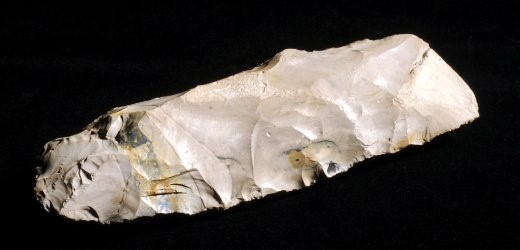A Stone Ax from Doggerland

Fish hate to freeze. In winter, when the weather becomes too uncomfortable, they tend to stay away from the coastlines and prefer to frolick in the warmer areas of deeper waters, where the fishermen must follow them in order to end up with an adequate catch. This is how, in the winter of 1988, Aart Wolters and his crew sailed in the direction of Bruine Bank, on board their “Op Hoop van Zegen.”
Bruine Bank, an area in the North Sea, is known to fishermen for mainly two things: the excellent catch rates when the weather is cold – and the bones, mammoth teeth, and even artefacts which frequently get caught in the nets and often cause annoying tears. This is what happened then. Among the squirming fish, a large stone ended up on deck. A well-worked-over stone. Wolters bagged it and brought it home.
The bones, teeth and artefacts stem from a long lost land, Doggerland. Until the end of the last Ice Age, about 8000 years ago, the North Sea was still a part of the continent, even beyond the British Isles. And one particularly fertile at that. Where is now the English Channel, alluvial plains were spreading, covered with a rich vegetation. “It was the true heart of Europe in the Mesolithic,” according to Richard Bates of Saint-Andrews University, Scotland. Innumerable birds bred in the high grasses. Nobody went hungry: wolves, bears, elks and horses ate their fill as well as the humans did. This paradise had long been populated. The oldest find is a fragment of a Neanderthal skull which is at least 35,000 years old – possibly even much older, up to 75,000 would be possible. 35,000 old stone tools of the Paleolithic have more than once been dragged inadvertendly to the surface by the fishermen with their mussel vacuum harvesters.
Wolters was a busy man. Only when he retired from being a fisherman did he find the time to pay closer attention to his find from the Bruine Bank. In January 2013, he showed it to Luc Amkreutz, curator for the Prehistory of the Netherlands at the National Museum of Antiquities at Leyden. At first, Amkreutz surmised that the ax stemmed from the Neolithic. But after closer examination, he corrected himself: this was a tranchet ax from the Mesolithic and it was between 12,000 and 6,000 years old.
We have in our museum a cudgel of smooth stone from a boulder, but I believe that this the is the first tranchet tax to come out of the North Sea – and maybe the first ever silex tool from this period,” says Amkreutz. This beautiful find was published in the Magazine “British Archaeology.”
The predecessor of Amkreutz, Louwe Kooijmans, had already studied intensively the finds from Doggerland. He had taken note of the fact that an especially large number of worked bones from the Mesolithic came from the area of the Bruine Bank. From all evidence, this must have been a place where the living and hunting were particularly easy. The newly found silex tool makes the whole picture of Mesolithic Doggerland a little bit more complete.
Angelika Frantz
Der Spiegel, 06.16.2013
(translated by Anne-Marie de Grazia)
The original article in German
In Sight of Doggerland: from speculative survey to landscape exploration
by Simon Fitch, Vince Gaffney and Ken Thompson
The North Sea has long been known by archaeologists as an area of Mesolithic occupation, and has even been argued as the heartland of the Mesolithic in North Western Europe. Yet this area remains effectively terra incognita to archaeologists, and the nature of its occupation, tantalisingly elusive. The submergence of this landscape has therefore effectively hindered archaeological research into this vitally important region. Yet this region contains one of the most detailed and comprehensive records of the Late Quaternary and Holocene, and its preserved sedimentary successions represent a mine of information that remains untapped by archaeologists. However the lack of direct data pertaining to this region results in all previous maps of the prehistoric landscape being at best hypothetical.
Go to the article in pdf

